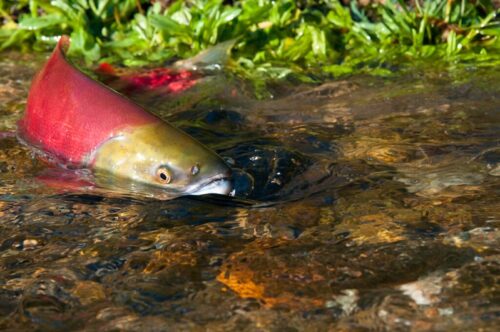News of the robust returns of wild sockeye to British Columbia’s rivers over the past several days has not troubled farmer Lawrence Albright, who produces sockeye salmon at his inland freshwater farm in Langley, BC.
Albright says his farmed sockeye is positioned for those times when wild sockeye is not in season.
“We only harvest and market them when the wild product is not available as fresh fish. That’s the reason we harvest from November to May,” he says.

Wild sockeye return to BC rivers beginning mid-May until August or September. The volume of wild salmon dictates the market price, and the farmed sockeye’s fixed production costs make it difficult to compete.
Terry Yoshikawa is the senior seafood buyer at Vancouver-based luxury food distributor Mikuni Wild Harvest, which exclusively distributes the farmed sockeye. He says the difference in prices between wild and farmed sockeye fluctuates.
The season for Copper River wild sockeye starts in mid-May, earlier than other wild salmon species. Yoshikawa explains its price is almost double that of farmed sockeye if he were to market it at that time.
“But when other areas start to open up, such as Cook Inlet, Prince William Inlet, Southeast Alaska, Bristol Bay, then prices for the wild sockeye become similar to the farmed sockeye. And that’s roughly in the US$7-8.50/lb range,” he told SalmonBusiness.
Albright, a retired aquaculture professor, uses a number of ways, including light, temperature and feeding regimens to time the harvest outside of this period.
Next harvest
“We have three different year classes in the farm now,” he said on Friday. “We’ve got very small ones, intermediate, and larger ones. The larger ones will be ready for harvest beginning in November.”
Yoshikawa is excited about the upcoming harvest. “We introduced Larry’s sockeye salmon to the pre-pandemic market about 2.5 years ago. We have since developed two significant markets: Vancouver and Greater Toronto Area, where the fish is sold to boutique retailers and restaurants.”
New markets are always on the horizon and certain markets will be more difficult, for example the prairie provinces, he said.
“It’s going to be a little bit more difficult simply because this is meat-and-potatoes country. It’s difficult to introduce something new, especially sustainable sockeye salmon.”
Expected harvest for this season is subject to growing conditions but the expectation is 5,000 lbs. Mikuni sells as head-on, gutted, gills-in. The condition of the gills are an excellent visual indication for freshness.
“It’s all HOG and we eviscerate the bellies but the gills we purposely keep. There’s a reason for that: as a fish buyer for over 35 years, I always look at the gills. Gills are an indication of the freshness,” he said.
Technology transfer
As for transferring the sockeye farming technology to other farmers, that side of the business will take time to develop, says Albright. He said the article about him and his farm in SalmonBusiness this past May has brought in inquiries.
“But I don’t expect much interest until the sockeye are firmly established in the market as a continuing product. They want to see that this is not a one-shot deal,” he said.
Yoskikawa says he too gets inquiries. “But because Larry and ourselves are not a multinational company, we don’t have millions of dollars to throw into developing our tanks, our feed system etc – that’s the difference.”
A farm in South Island, New Zealand is trialling the culture of sockeye in freshwater. Its first harvest is at least two years away from commercialization, he said.
“We know that there’s at least one other company other than the one in New Zealand now trying to raise farmed sockeye but they’re going to struggle as it’s a really difficult fish to culture.”


